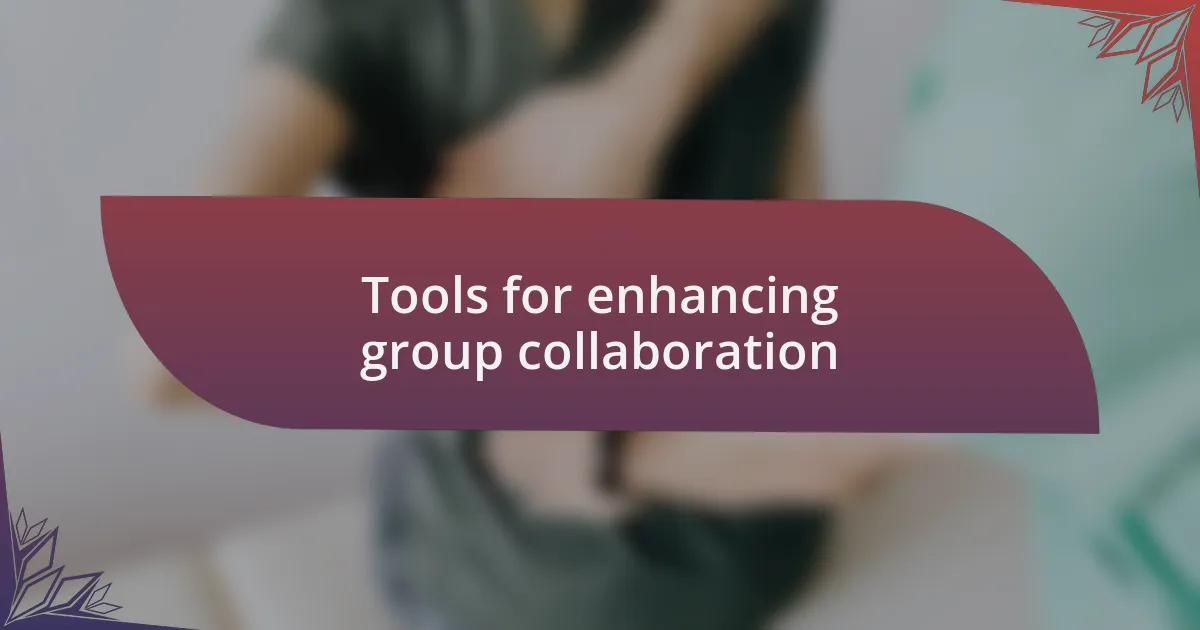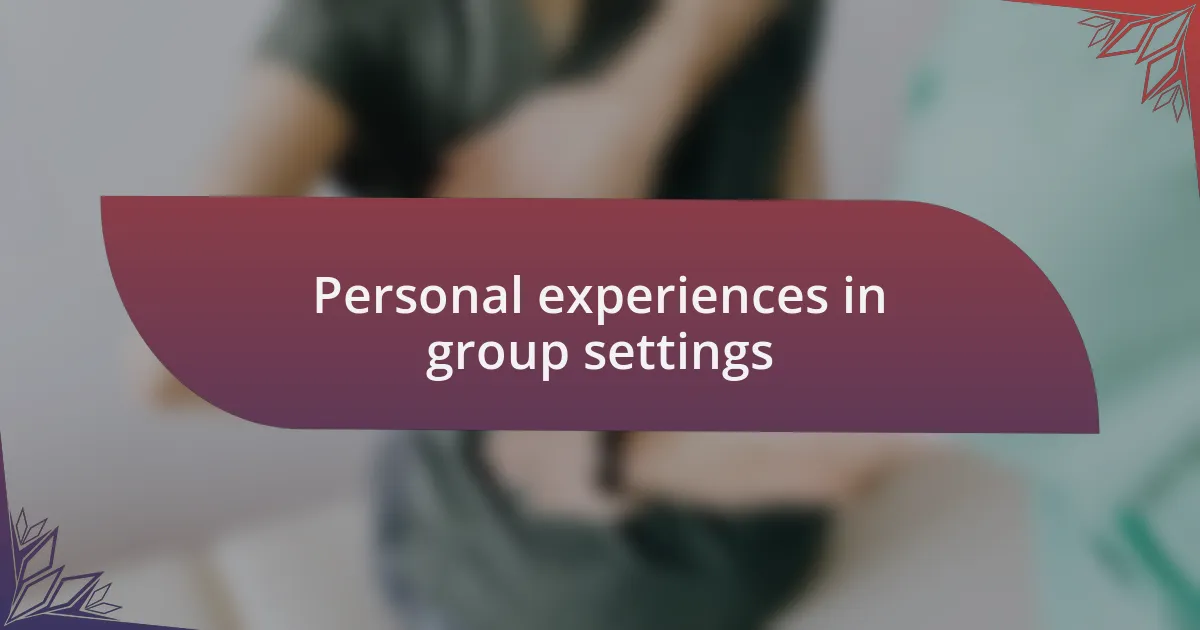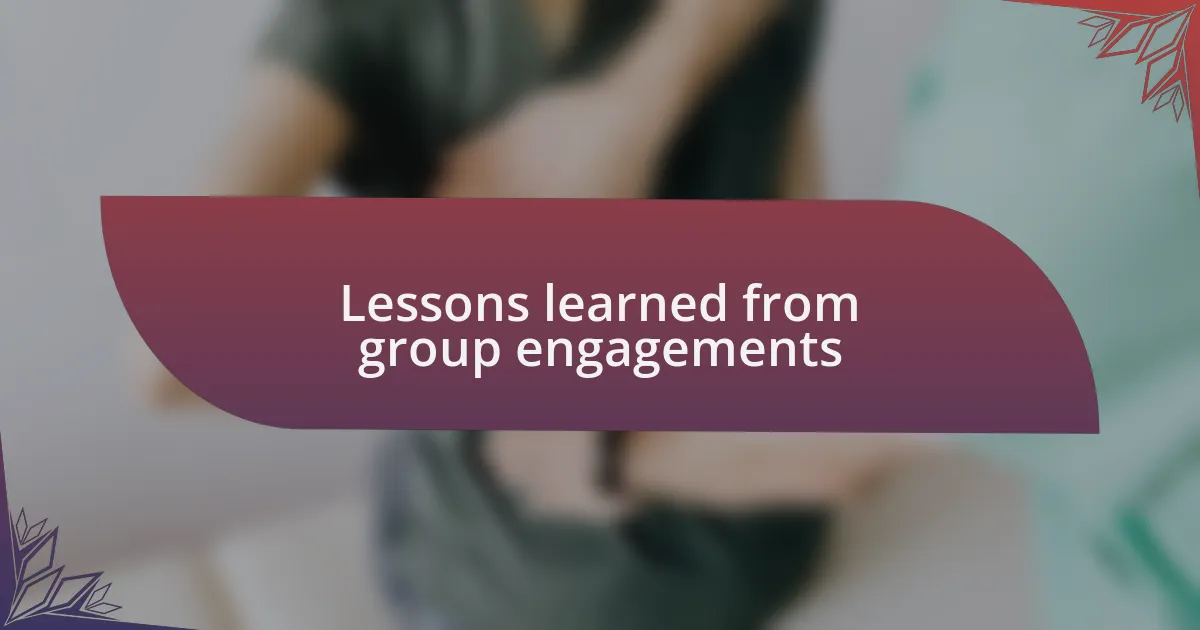Key takeaways:
- Effective communication is essential in group settings to enhance engagement and prevent misunderstandings.
- Active listening, clear roles, and celebrating small wins are vital strategies for successful group interactions.
- Utilizing collaborative tools and technology can significantly improve communication and streamline project management.
- Building trust through vulnerability and flexible discussions fosters deeper connections and more effective outcomes.

Importance of effective communication
Effective communication in group engagements isn’t just beneficial; it’s essential. I remember a community health meeting where misunderstandings nearly derailed our efforts. It struck me how clear dialogue transformed the atmosphere, allowing everyone to share their insights without hesitation. Have you ever noticed how open lines of communication can lighten the mood in tense discussions?
Moreover, without effective communication, critical information can slip through the cracks, leading to inadequate health interventions. I once participated in a workshop where a simple miscommunication caused a two-week delay in implementing a health initiative. It left me wondering: how often have we failed to act promptly because we didn’t truly connect with one another?
I’ve observed that when team members feel heard, their engagement soars. During a recent project, acknowledging each person’s contributions created a sense of ownership. It’s incredible how much buy-in can come from just practicing empathy and understanding. What do you think happens to a group’s spirit when communication takes center stage?

Strategies for successful group interactions
One strategy I find invaluable for successful group interactions is the power of active listening. I recall a time in a public health outreach meeting when a quieter member shared a unique perspective that had the potential to shift our approach. By truly listening, we not only validated their contribution but also sparked a deeper conversation that enriched our entire project. Have you ever experienced how a simple nod of understanding can empower someone to speak up?
Another effective tactic is establishing clear roles within the group. During a health initiative I coordinated, assigning specific responsibilities helped reduce confusion and increased accountability. Each member understood how they fit into the bigger picture, which fostered teamwork and boosted morale. It’s fascinating to consider how clarity in roles can energize a group’s dynamics, don’t you think?
Finally, celebrating small wins can significantly enhance group cohesion. I remember a project where we took a moment to acknowledge our progress, no matter how minor it seemed. This practice not only boosted our motivation but also created a positive atmosphere that encouraged further contributions. How often do we overlook the importance of recognition in driving a group forward? By valuing each step, we nurture an environment that thrives on collective achievements.

Tools for enhancing group collaboration
Utilizing collaborative tools can significantly enhance group engagement and streamline communication. In one of my public health initiatives, we incorporated shared digital workspaces like Google Docs, allowing team members to edit and comment in real-time. This not only kept us aligned, but it also created a sense of ownership among the participants. Have you ever felt more invested in a project when you could see your input directly shaping the outcome?
Another tool I really appreciate is video conferencing software, especially in instances where team members can’t meet in person. I recall a vivid discussion during a virtual meeting where we brainstormed ideas for a community health intervention. The ability to engage face-to-face, even through a screen, fostered a connection that emails just couldn’t replicate. Isn’t it fascinating how technology can bridge gaps and create a shared space for collaboration?
Lastly, project management applications such as Trello or Asana can organize our collective efforts effectively. In one project, we visualized our tasks and deadlines, which minimized anxiety surrounding deliverables. I’ve noticed that when everyone is aware of their responsibilities and the project’s timeline, it generates a more focused and cohesive group effort. How often do we underestimate the power of organization in achieving our goals?

Personal experiences in group settings
In group settings, I’ve often found that establishing trust is crucial for meaningful engagement. During a health awareness workshop, I shared a personal story that resonated with many attendees. The moment I opened up about my own struggles with mental health, I noticed an immediate shift; others felt encouraged to share their experiences too. It was a powerful reminder of how vulnerability can forge strong connections.
I also remember a time when we faced a disagreement during a project. Instead of pushing for my viewpoint, I facilitated a roundtable discussion, encouraging everyone to voice their opinions. The atmosphere was electric—what started as tension transformed into collaboration as we jointly developed a solution. Isn’t it amazing how embracing diverse viewpoints can lead to richer outcomes?
Lastly, I strive to engage through interactive activities, such as small group discussions. During one session on nutrition, dividing participants into smaller teams allowed everyone to contribute. Observing their faces light up as they brainstormed together reinforced my belief that participation fosters commitment. Have you ever experienced that rush of energy when ideas flow freely in a group? It’s moments like these that highlight the magic of collective engagement.

Lessons learned from group engagements
One of the most significant lessons I’ve taken away from group engagements is the importance of active listening. I recall a community meeting where participants shared their concerns about access to healthcare. I made a conscious effort to listen attentively, nodding and reflecting back what I heard. This small yet impactful approach not only validated their feelings but also encouraged others to speak up. Isn’t it intriguing how the simple act of listening can foster a deeper sense of connection?
Another insight was the value of flexibility during discussions. During a planning session for a public health initiative, the agenda shifted dramatically when participants began sharing unexpected insights related to cultural beliefs. Instead of steering the conversation back to my original plan, I embraced the change. This adaptability opened the door to rich dialogue and innovative solutions that we hadn’t considered before. Have you ever been surprised by the direction a conversation can take when you let go of rigid plans?
Finally, I learned that celebrating small victories boosts morale in group settings. After completing a health campaign, I organized a brief gathering to acknowledge everyone’s contributions. It was heartwarming to see smiles on faces and hear laughter fill the room. Taking a moment to reflect on our achievements, no matter how small, can create a profound sense of community and purpose. Who doesn’t love a good celebration after hard work? It’s those moments that truly solidify the bonds we form through shared experiences.

Future improvements for group interactions
To improve group interactions, I believe incorporating technology can be transformative. For instance, I’ve seen online platforms enhance communication by allowing participants to engage even outside formal meetings. Imagine how empowering it feels to share ideas in a collaborative digital workspace—a tool that’s constantly open for brainstorming and feedback. Wouldn’t that create a more inclusive environment for diverse voices?
Additionally, establishing regular check-ins can foster deeper connections. In my experience, a simple 10-minute catch-up before diving into the agenda can break the ice and build trust. It allows members to share not just their professional updates but personal milestones too. How often have you noticed that when people feel known, they engage more genuinely?
Finally, consider creating smaller breakout groups during larger discussions. I’ve found that when groups can delve into subtopics, it opens up the floor for everyone to contribute meaningfully. Have you ever felt overwhelmed in a big gathering, wishing for a chance to speak in a smaller circle? Those more intimate settings can spark lively discussions that get lost in larger forums, ultimately enriching the entire group experience.